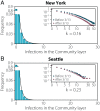Quantifying the importance and location of SARS-CoV-2 transmission events in large metropolitan areas
- PMID: 35696558
- PMCID: PMC9245708
- DOI: 10.1073/pnas.2112182119
Quantifying the importance and location of SARS-CoV-2 transmission events in large metropolitan areas
Abstract
Detailed characterization of severe acute respiratory syndrome coronavirus 2 (SARS-CoV-2) transmission across different settings can help design less disruptive interventions. We used real-time, privacy-enhanced mobility data in the New York City, NY and Seattle, WA metropolitan areas to build a detailed agent-based model of SARS-CoV-2 infection to estimate the where, when, and magnitude of transmission events during the pandemic's first wave. We estimate that only 18% of individuals produce most infections (80%), with about 10% of events that can be considered superspreading events (SSEs). Although mass gatherings present an important risk for SSEs, we estimate that the bulk of transmission occurred in smaller events in settings like workplaces, grocery stores, or food venues. The places most important for transmission change during the pandemic and are different across cities, signaling the large underlying behavioral component underneath them. Our modeling complements case studies and epidemiological data and indicates that real-time tracking of transmission events could help evaluate and define targeted mitigation policies.
Keywords: COVID-19; location; mobility; superspreading event.
Conflict of interest statement
Competing interest statement: A.V., M.C., and A.P.y.P. report grants from Metabiota, Inc., outside of the submitted work; M.A. received research funding from Seqirus; and M.E.H. reports grants from the National Institute of General Medical Sciences during the conduct of the study; The authors declare no other relationships or activities that could appear to have influenced the submitted work.
Figures





References
-
- Badr H., et al. ., Social distancing is effective at mitigating COVID-19 transmission in the United States. medRxiv [Preprint] (2020). 10.1101/2020.05.07.20092353. Accessed 17 December 2020. - DOI
-
- Wu J. Y., et al. ., Changes in reproductive rate of SARS-CoV-2 due to non-pharmaceutical interventions in 1,417 U.S. counties. medRxiv [Preprint] (2020). 10.1101/2020.05.31.20118687. Accessed 17 December 2020. - DOI
-
- Cintia P., et al. ., The relationship between human mobility and viral transmissibility during the COVID-19 epidemics in Italy. arXiv [Preprint] (2020). 10.48550/arXiv.2006.03141. Accessed 17 December 2020. - DOI
Publication types
MeSH terms
Grants and funding
LinkOut - more resources
Full Text Sources
Medical
Miscellaneous

